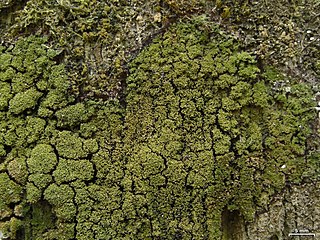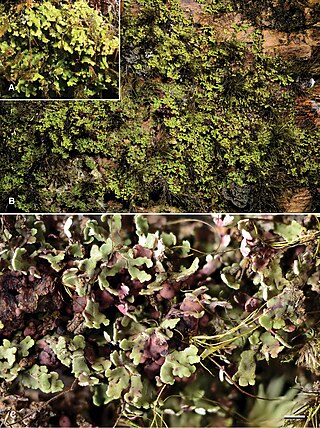Scutula is a genus of lichenicolous fungi in the family Ramalinaceae.

Bacidina is a genus of lichens in the family Ramalinaceae. It was circumscribed by Czech lichenologist Antonín Vězda in 1990, with Bacidina phacodes assigned as the type species. Vězda included 11 species in Bacidina, which was originally classified in the Lecideaceae. These species had previously been placed in genus Bacidia.
Aciculopsora is a genus of lichens in the family Ramalinaceae. It was circumscribed by lichenologists André Aptroot and Marie Trest in 2006.
Myelorrhiza is a genus of two Australian species of lichenized fungi in the family Ramalinaceae. It was circumscribed in 1986 by Australian lichenologists Doug Verdon and John A. Elix. Myelorrhiza was originally classified in the family Cladoniaceae until Kistenich and colleagues, using molecular phylogenetic analysis, showed that it is more appropriately placed with the Ramalinaceae.
Crustospathula is a genus of five species of crustose lichens in the family Malmideaceae. They are characterized by their stalked and sometimes branched cartilaginous soredia and Bacidia-like apothecia.
Rolfidium is a genus of lichenized fungi in the family Ramalinaceae.

Phyllopsora is a genus of lichenized fungi in the family Ramalinaceae. It was circumscribed by Swiss botanist Johannes Müller Argoviensis in 1894.
Toniniopsis is a genus of crustose and squamulose lichens in the family Ramalinaceae. The genus was circumscribed by Swiss lichenologist Eduard Frey in 1926, with Toniniopsis obscura designated the type and only species. The genus name of Toniniopsis is in honour of Carlo Tonini (1803–1877), who was an Italian chemist and botanist (Lichenology), who worked in Verona and was a member and President of the Academy of Agriculture. As a result of molecular phylogenetic studies, several species, formerly classified in genus Bacidia, have been transferred to Toniniopsis.

Toninia is a genus of lichen-forming fungi in the family Ramalinaceae.
Dictyonema is a genus of mainly tropical basidiolichens in the family Hygrophoraceae.
Hildur Krog was a Norwegian botanist.

Malmideaceae is a family of crustose and corticolous lichens in the order Lecanorales. It contains eight genera and about 70 species.

Bilimbia is a genus of lichen-forming fungi in the family Ramalinaceae.
Bibbya is a genus of fruticose lichens in the family Ramalinaceae.
Toensbergia is a genus of lichen-forming fungi in the family Sporastatiaceae. The genus was circumscribed by Mika Bendiksby and Einar Timdal in 2013. The genus name honours Norwegian lichenologist Tor Tønsberg, "in appreciation of his important work on sorediate, corticolous lichens". The type species is Toensbergia leucococca, which was formerly classified in genus Hypocenomyce, presumably due to its resemblance to Hypocenomyce xanthococca.
Biatora oxneri is a species of corticolous (bark-dwelling) lichen in the family Ramalinaceae. It is found in the Russian Far East and in South Korea.
Krogia microphylla is a rare species of corticolous (bark-dwelling), squamulose (scaley) lichen in the family Ramalinaceae. Found in the Dominican Republic, it was formally described as a new species in 2011 by lichenologist Einar Timdal. The type specimen was collected from a cloud forest in El Seibo Province at an altitude of about 450 m (1,480 ft). It is only known from the type collection. The species epithet refers to the tiny squamules that make up the thallus.
Phyllopsora amazonica is a species of corticolous (bark-dwelling), crustose lichen in the family Ramalinaceae. It is found in the Amazon rainforest of Brazil.
Phyllopsora concinna is a species of corticolous (bark-dwelling), squamulose (scaley) lichen in the family Ramalinaceae. Found in Central and South America, it was formally described as a new species in 2019 by lichenologists Sonja Kistenich and Einar Timdal. The lichen has a scaley, effuse (spread-out) thallus that is pale green with a well-developed, white prothallus. Apothecia occur rarely; they are brownish with a paler margin, measuring up to 1 mm in diameter. Ascospores are simple with a narrow ellipsoid to fusiform shape, and dimensions of 12.5–16·0 by 3.5–4.0 μm. Atranorin and parvifoliellin are major lichen products that occur in this species. The latter compound distinguishes it chemically from the morphologically similar species Phyllopsora cinchonarum, which instead contains lobaric acid. The botanical name concinna, refers to its "beautiful" appearance.

Krogia macrophylla is a species of corticolous (bark-dwelling) lichen in the family Ramalinaceae. Found in New Caledonia, it was formally described as a new species in 2018. It is distinguished from other Krogia species by its relatively larger squamules and the production of a chemical substance similar to boninic acid. The species grows predominantly on tree trunks in moist or wet tropical forests.






